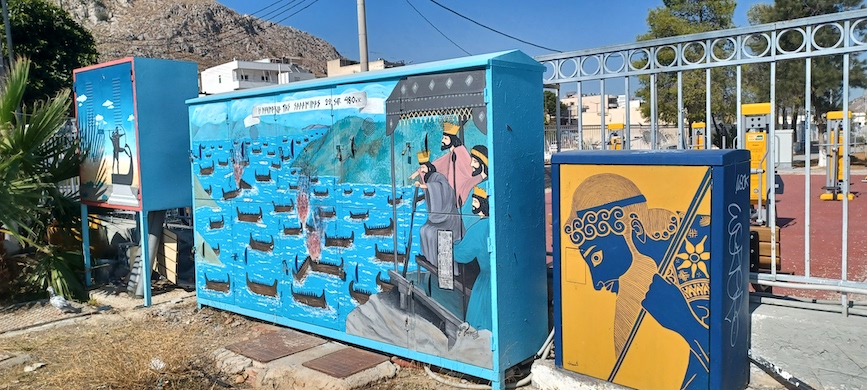This Little Greek Island Couldn’t Give a Hoot About Jeff Bezos’s Yacht
Spend a few hours at Salamis for a deep dive into a battle that changed the world.

SALAMINA, Greece — Greek summer is loosely the Hellenic equivalent of the Hollywood awards season, when all eyes are on the A-list celebrities who keep an entire industry afloat. Here, those stars come in the form of islands, some better known than others but all ready for their annual close-ups this time of year when the yachts of the rich and famous ply the Aegean and Ionian seas.
This week saw the chartered yacht of a former French president, Nicholas Sarkozy, drop anchor at rocky Folegandros, and Paris Hilton flaunted a Barbie-style bikini aboard her boat, sailing somewhere in the Greek seas.
Then there was Jeff Bezos, whose $500 million superyacht, Koru, is so big it requires a support yacht, the merely $75 million Abeona. On Friday, both vessels were spotted off the coast of a green island steeped in mythology: Ithaca. “Keep Ithaca always in your mind,” the poet Cavafy wrote, and as the late Scottish actor Sean Connery reminded us.
Yet instead of setting out for Ithaca, the other day I hopped aboard a lumbering car ferry bound for an unglamorous island with not a yacht in sight — one grounded in a different kind of might: Salamis.
Cavafy stated that the traveler should hope the road is a long one, but I was glad that the trip to Salamina, as the island is called locally, took less than 15 minutes. While not shrouded in the same kind of mystique as Ithaca or fire-chiseled Santorini, Salamis has a military pedigree second to none, at least not in these parts.
In its waters was fought the Battle of Salamis in 480 B.C., when the Athenian navy, led by Themistocles and supported by allied Greek city-states, beat back the Persians. The Greeks were outnumbered but the Persians were outmaneuvered, and their fleet destroyed.

That Greek victory made King Xerxes shake in his sandals. It was a turning point in the Greco-Persian wars and changed the course of world history. The Battle of Salamis has rightly been called one of the stepping stones of the democratic principle of government.
Today, the irregularly shaped island is home to the headquarters of the Hellenic navy. Superyachts are nice, presumably, but there can be little doubt that the kinds of ships you see lined up in Salamina’s harbors are the true masters of the seas.
What Salamis may lack in overt beauty and charm it more than makes up for in heritage and verve. When this correspondent told some Athenian friends of his intention to spend the better part of a weekend on the island, it drew heaps of scorn, as in terms of touristic allure it is more comparable to, say, Staten Island than the Hamptons.
So what? To some people, there is nothing more dreary than idling away at a beach for hours on end. Salamis does have beaches, of course, though it is necessary to head to the southern reaches of the island to escape some of the industrial port grit. There, facing the Saronic Gulf and the island of Aegina, are some quiet coves. There are no beach bars, but the clear water is decent for swimming. The Cave of Euripides is also in this area.
Salamis has a fine archaeological museum that was renovated a few years ago. When I visited, a staff member had to turn on the lights because I was the only other person there. There are more remarkable artifacts across the water in the archaeological museum of Piraeus, such as a bronze chunk of an ancient Athenian trireme, but the galleries offer a window onto the sweep of history here from late Neolithic to Roman and Early Christian times.
The monument of the Salamina fighters, a large bronze sculpture, overlooks the sea where the battle took place. It is situated at the tip of a promontory called Kinosaura that juts like a spear into the narrow channel that separates Salamis from the mainland. An ancient tumulus on the spot served as the burial site for the Greek warriors who fell in battle.
Unlike at other ancient sites such as Marathonas, this place does not really dwell in the past. The waters teem with oil tankers and container ships, the dockyards groan with activity, the big ferries that connect the island with the mainland operate 24 hours a day.
And yet, the naval victory looms large in the local consciousness — a marble commemorative statue here, a Greek flag hoisted high and fluttering in the salt-heavy breeze there. Near a charming seaside spot where I had a typical lunch of fried codfish with skordalia purée, local students had painted metal utility boxes with colorful imagined scenes from the famous showdown at sea.
Imagination generally is not something that generates as much publicity and intrigue as billionaires’ yachts, but it might be nice if sometimes it did.

